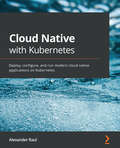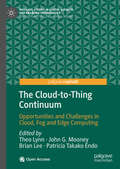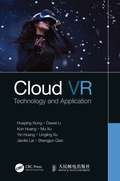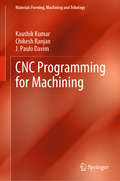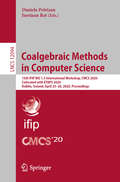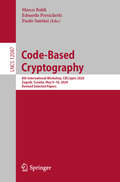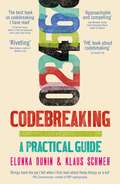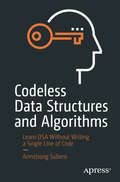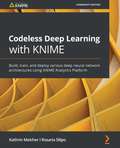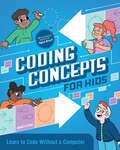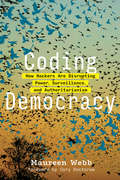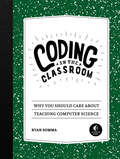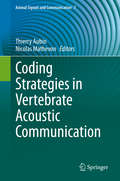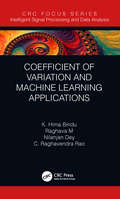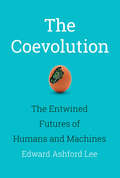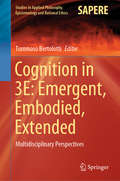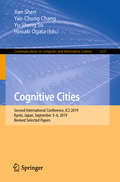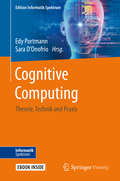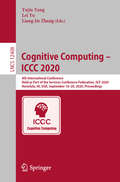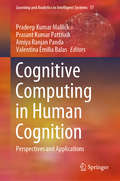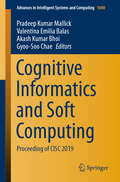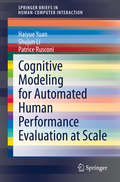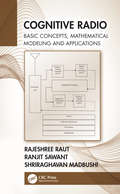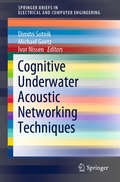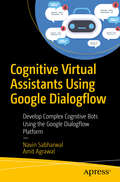- Table View
- List View
Cloud Native with Kubernetes
by Alexander RaulThis book is for developers, architects, DevOps engineers, or anyone interested in developing and managing cloud-native applications. Those already running cloud applications and looking for a better way to manage their platform or others interested in a career change given the recent popularity of Kubernetes will also find this book helpful. Some familiarity with cloud computing, containers and DevOps is required, but no prior knowledge of building production applications using Kubernetes is needed to get started with this book.
The Cloud-to-Thing Continuum: Opportunities and Challenges in Cloud, Fog and Edge Computing (Palgrave Studies in Digital Business & Enabling Technologies)
by Theo Lynn John G. Mooney Brian Lee Patricia Takako EndoThe Internet of Things offers massive societal and economic opportunities while at the same time significant challenges, not least the delivery and management of the technical infrastructure underpinning it, the deluge of data generated from it, ensuring privacy and security, and capturing value from it.This Open Access Pivot explores these challenges, presenting the state of the art and future directions for research but also frameworks for making sense of this complex area. This book provides a variety of perspectives on how technology innovations such as fog, edge and dew computing, 5G networks, and distributed intelligence are making us rethink conventional cloud computing to support the Internet of Things. Much of this book focuses on technical aspects of the Internet of Things, however, clear methodologies for mapping the business value of the Internet of Things are still missing. We provide a value mapping framework for the Internet of Things to address this gap. While there is much hype about theInternet of Things, we have yet to reach the tipping point. As such, this book provides a timely entrée for higher education educators, researchers and students, industry and policy makers on the technologies that promise to reshape how society interacts and operates.
Cloud VR: Technology and Application
by Huaping Xiong Dawei Li Kun Huang Mu Xu Yin Huang Lingling Xu Jianfei Lai Shengjun QianBased on the technical accumulation and practice of Huawei iLab in the Cloud VR field, this book systematically describes the advantages of Cloud VR technologies; technical requirements on clouds, networks, and terminals as well as solution implementation; Cloud VR experience evaluation baselines and methods; and current business practices. Cloud VR introduces cloud computing and cloud rendering to VR services. With fast and stable networks, cloud-based display output and audio output are coded, compressed, and transmitted to user terminals, implementing cloud-based VR service content and content rendering. Cloud VR has stringent requirements on bandwidth and latency, making it a proficient application for 5G and gigabit home broadband networks in the era of "dual G". As the first advocate of Cloud VR, Huawei iLab developed the first prototype of the Cloud VR technical solution, initiated the industry’s first Cloud VR industry cooperation plan – VR OpenLab with partners – and incubated the world’s first Cloud VR commercial project with China Mobile Fujian. Cloud VR: Technology and Application is the first official publication of Huawei iLab’s research and practice achievements. It systematically and thoroughly introduces the Cloud VR concept, solution architecture, key technologies, and business practices and is of great value in academic and social applications. This book is easy to understand, practical, and suitable for VR vendors, VR technology enthusiasts, carriers, network vendors, cloud service providers, universities, and other enterprises and scientific research institutes.
CNC Programming for Machining (Materials Forming, Machining and Tribology)
by J. Paulo Davim Kaushik Kumar Chikesh RanjanThe book is basically written with a view to project Computer Numerical Control Programming (CNC) Programming for machines. This book shows how to write, read and understand such programs for modernizating manufacturing machines. It includes topics such as different programming codes as well as different CNC machines such as drilling and milling.
Coalgebraic Methods in Computer Science: 15th IFIP WG 1.3 International Workshop, CMCS 2020, Colocated with ETAPS 2020, Dublin, Ireland, April 25–26, 2020, Proceedings (Lecture Notes in Computer Science #12094)
by Daniela Petrişan Jurriaan RotThis book constitutes the thoroughly refereed post-conference proceedings of the 15th International Workshop on Coalgebraic Methods in Computer Science, CMCS 2020, colocated with ETAPS 2020, held in Dublin, Ireland, in April 2020. The conference was held as several online events in September and October due to the COVID-19 pandemic. The 9 revised full papers were carefully reviewed and selected from 13 submissions. Also included is one invited talk. The papers cover a wide range of topics in the theory, logics, and applications of coalgebras.
Code-Based Cryptography: 8th International Workshop, CBCrypto 2020, Zagreb, Croatia, May 9–10, 2020, Revised Selected Papers (Lecture Notes in Computer Science #12087)
by Marco Baldi Edoardo Persichetti Paolo SantiniThis book constitutes the refereed and revised post-conference proceedings of the 8th International Workshop on Code-Based Cryptography, CBCrypto 2020, held in Zagreb, Croatia, in May 2020.*The seven papers presented in this book were carefully reviewed and selected from numerous submissions. These contributions focus on various topics such as code-based cryptography, from design to implementation, security, new systems, and improved decoding algorithms. * The conference was held virtually due to the COVID-19 pandemic.
Codebreaking: A Practical Guide
by Elonka Dunin Klaus Schmeh'The best book on codebreaking I have read', SIR DERMOT TURING 'Brings back the joy I felt when I first read about these things as a kid', PHIL ZIMMERMANN 'This is at last the single book on codebreaking that you must have. If you are not yet addicted to cryptography, this book will get you addicted. Read, enjoy, and test yourself on history's great still-unbroken messages!' JARED DIAMOND is the Pulitzer Prize-winning author of Guns, Germs, and Steel; Collapse; and other international bestsellers'This is THE book about codebreaking. Very concise, very inclusive and easy to read', ED SCHEIDT'Riveting', MIKE GODWIN 'Approachable and compelling', GLEN MIRANKERThis practical guide to breaking codes and solving cryptograms by two world experts, Elonka Dunin and Klaus Schmeh, describes the most common encryption techniques along with methods to detect and break them. It fills a gap left by outdated or very basic-level books. This guide also covers many unsolved messages. The Zodiac Killer sent four encrypted messages to the police. One was solved; the other three were not. Beatrix Potter's diary and the Voynich Manuscript were both encrypted - to date, only one of the two has been deciphered. The breaking of the so-called Zimmerman Telegram during the First World War changed the course of history. Several encrypted wartime military messages remain unsolved to this day. Tens of thousands of other encrypted messages, ranging from simple notes created by children to encrypted postcards and diaries in people's attics, are known to exist. Breaking these cryptograms fascinates people all over the world, and often gives people insight into the lives of their ancestors. Geocachers, computer gamers and puzzle fans also require codebreaking skills.This is a book both for the growing number of enthusiasts obsessed with real-world mysteries, and also fans of more challenging puzzle books. Many people are obsessed with trying to solve famous crypto mysteries, including members of the Kryptos community (led by Elonka Dunin) trying to solve a decades-old cryptogram on a sculpture at the centre of CIA Headquarters; readers of the novels of Dan Brown as well as Elonka Dunin's The Mammoth Book of Secret Code Puzzles (UK)/The Mammoth Book of Secret Codes and Cryptograms (US); historians who regularly encounter encrypted documents; perplexed family members who discover an encrypted postcard or diary in an ancestor's effects; law-enforcement agents who are confronted by encrypted messages, which also happens more often than might be supposed; members of the American Cryptogram Association (ACA); geocachers (many caches involve a crypto puzzle); puzzle fans; and computer gamers (many games feature encryption puzzles). The book's focus is very much on breaking pencil-and-paper, or manual, encryption methods. Its focus is also largely on historical encryption. Although manual encryption has lost much of its importance due to computer technology, many people are still interested in deciphering messages of this kind.
Codeless Data Structures and Algorithms: Learn DSA Without Writing a Single Line of Code
by Armstrong SuberoIn the era of self-taught developers and programmers, essential topics in the industry are frequently learned without a formal academic foundation. A solid grasp of data structures and algorithms (DSA) is imperative for anyone looking to do professional software development and engineering, but classes in the subject can be dry or spend too much time on theory and unnecessary readings. Regardless of your programming language background, Codeless Data Structures and Algorithms has you covered.In this book, author Armstrong Subero will help you learn DSAs without writing a single line of code. Straightforward explanations and diagrams give you a confident handle on the topic while ensuring you never have to open your code editor, use a compiler, or look at an integrated development environment. Subero introduces you to linear, tree, and hash data structures and gives you important insights behind the most common algorithms that you can directly apply to your own programs. Codeless Data Structures and Algorithms provides you with the knowledge about DSAs that you will need in the professional programming world, without using any complex mathematics or irrelevant information. Whether you are a new developer seeking a basic understanding of the subject or a decision-maker wanting a grasp of algorithms to apply to your projects, this book belongs on your shelf. Quite often, a new, refreshing, and unpretentious approach to a topic is all you need to get inspired. What You'll LearnUnderstand tree data structures without delving into unnecessary details or going into too much theoryGet started learning linear data structures with a basic discussion on computer memory Study an overview of arrays, linked lists, stacks and queuesWho This Book Is ForThis book is for beginners, self-taught developers and programmers, and anyone who wants to understand data structures and algorithms but don’t want to wade through unnecessary details about quirks of a programming language or don’t have time to sit and read a massive book on the subject. This book is also useful for non-technical decision-makers who are curious about how algorithms work.
Codeless Deep Learning with KNIME: Build, Train, And Deploy Various Deep Neural Network Architectures Using Knime Analytics Platform
by Rosaria Silipo Kathrin MelcherThis book is for data analysts, data scientists, and deep learning developers who are not well versed with Python but want to learn how to use KNIME GUI to build, train, test, and deploy neural networks with different architectures. The practical implementations shown in the book do not require coding or any knowledge of dedicated scripts, allowing you to quickly translate theoretical concepts into practical applications. No previous knowledge of KNIME is required.
Coding Concepts for Kids: Learn to Code Without a Computer
by Randy LynnCoding for kids without a computer—an offline skill-building book for ages 5 to 7 Coding helps kids develop analytical thinking, problem-solving abilities, and beyond! In this exciting guide to coding for kids, your child will discover the core concepts of coding through colorful games and activities—without using a computer. These fun challenges can be done right inside the book or with everyday objects to help kids practice the same skills coders use, like writing clear instructions, recognizing patterns, and working efficiently. There's even a place for your beginner to invent their own codes! This coding for kids book features: Coding fundamentals—Practice algorithms, loops, conditionals, optimization, debugging, and variables with games that help kids think like a computer programmer. Meet the coder crew—Explore coding for kids with a whole cast of characters, including Al the helper, Pixel the creative expert, Lo the problem-solver, Bug the pattern-spotter, and their robot dog Spot the Bot! On and off the page—Sharpen skills with fun on-the-page puzzles and off-the-page activities that give kids a chance to practice in different ways. Set your little ones up for success with coding for kids that only requires a pencil, paper, and their imagination.
Coding Democracy: How Hackers Are Disrupting Power, Surveillance, and Authoritarianism (The\mit Press Ser.)
by Maureen WebbHackers as vital disruptors, inspiring a new wave of activism in which ordinary citizens take back democracy.Hackers have a bad reputation, as shady deployers of bots and destroyers of infrastructure. In Coding Democracy, Maureen Webb offers another view. Hackers, she argues, can be vital disruptors. Hacking is becoming a practice, an ethos, and a metaphor for a new wave of activism in which ordinary citizens are inventing new forms of distributed, decentralized democracy for a digital era. Confronted with concentrations of power, mass surveillance, and authoritarianism enabled by new technology, the hacking movement is trying to “build out” democracy into cyberspace.Webb travels to Berlin, where she visits the Chaos Communication Camp, a flagship event in the hacker world; to Silicon Valley, where she reports on the Apple-FBI case, the significance of Russian troll farms, and the hacking of tractor software by desperate farmers; to Barcelona, to meet the hacker group XNet, which has helped bring nearly 100 prominent Spanish bankers and politicians to justice for their role in the 2008 financial crisis; and to Harvard and MIT, to investigate the institutionalization of hacking. Webb describes an amazing array of hacker experiments that could dramatically change the current political economy. These ambitious hacks aim to displace such tech monoliths as Facebook and Amazon; enable worker cooperatives to kill platforms like Uber; give people control over their data; automate trust; and provide citizens a real say in governance, along with capacity to reach consensus. Coding Democracy is not just another optimistic declaration of technological utopianism; instead, it provides the tools for an urgently needed upgrade of democracy in the digital era.
Coding in the Classroom: Why You Should Care About Teaching Computer Science
by Ryan SommaA book for anyone teaching computer science, from elementary school teachers and coding club coaches to parents looking for some guidance.Computer science opens more doors for today's youth than any other discipline - which is why Coding in the Classroom is your key to unlocking students' future potential. Author Ryan Somma untangles the current state of CS education standards; describes the cognitive, academic, and professional benefits of learning CS; and provides numerous strategies to promote computational thinking and get kids coding! Whether you're a teacher, an after-school coach, or a parent seeking accessible ways to boost your kid's computer savvy, Coding in the Classroom is here to help. With quick-start programming strategies, scaffolded exercises for every grade level, and ideas for designing CS events that promote student achievement, this book is a rock-solid roadmap to CS integration from a wide variety of on-ramps. You'll learn: • tips and resources for teaching programming concepts via in-class activities and games, without a computer • development environments that make coding and sharing web apps a breeze • lesson plans for the software lifecycle process and techniques for facilitating long-term projects • ways to craft interdisciplinary units that bridge CS and computational thinking with other content areas Coding in the Classroom does more than make CS less formidable - it makes it more fun! From learning computational thinking via board games to building their own websites, students are offered a variety of entry points for acquiring the skills they need to succeed in the 21st-century workforce. Moreover, Somma understands how schools operate - and he's got your back. You'll be empowered to advocate for the value of implementing CS across the curriculum, get stakeholder buy-in, and build the supportive, equitable coding community that your school deserves.
Coding Strategies in Vertebrate Acoustic Communication (Animal Signals and Communication #7)
by Thierry Aubin Nicolas MathevonInformation is a core concept in animal communication: individuals routinely produce, acquire, process and store information, which provides the basis for their social life. This book focuses on how animal acoustic signals code information and how this coding can be shaped by various environmental and social constraints. Taking birds and mammals, including humans, as models, the authors explore such topics as communication strategies for “public” and “private” signaling, static and dynamic signaling, the diversity of coded information and the way information is decoded by the receiver. The book appeals to a wide audience, ranging from bioacousticians, ethologists and ecologists to evolutionary biologists. Intended for students and researchers alike, it promotes the idea that Shannon and Weaver’s Mathematical Theory of Communication still represents a strong framework for understanding all aspects of the communication process, including its dynamic dimensions.
Coefficient of Variation and Machine Learning Applications (Intelligent Signal Processing and Data Analysis)
by K. Hima Bindu Raghava Morusupalli Nilanjan Dey C. Raghavendra RaoCoefficient of Variation (CV) is a unit free index indicating the consistency of the data associated with a real-world process and is simple to mold into computational paradigms. This book provides necessary exposure of computational strategies, properties of CV and extracting the metadata leading to efficient knowledge representation. It also compiles representational and classification strategies based on the CV through illustrative explanations. The potential nature of CV in the context of contemporary Machine Learning strategies and the Big Data paradigms is demonstrated through selected applications. Overall, this book explains statistical parameters and knowledge representation models.
The Coevolution: The Entwined Futures of Humans and Machines (The\mit Press Ser.)
by Edward Ashford LeeShould digital technology be viewed as a new life form, sharing our ecosystem and coevolving with us?Are humans defining technology, or is technology defining humans? In this book, Edward Ashford Lee considers the case that we are less in control of the trajectory of technology than we think. It shapes us as much as we shape it, and it may be more defensible to think of technology as the result of a Darwinian coevolution than the result of top-down intelligent design. Richard Dawkins famously said that a chicken is an egg's way of making another egg. Is a human a computer's way of making another computer? To understand this question requires a deep dive into how evolution works, how humans are different from computers, and how the way technology develops resembles the emergence of a new life form on our planet.Lee presents the case for considering digital beings to be living, then offers counterarguments. What we humans do with our minds is more than computation, and what digital systems do—be teleported at the speed of light, backed up, and restored—may never be possible for humans. To believe that we are simply computations, he argues, is a “dataist” faith and scientifically indefensible. Digital beings depend on humans—and humans depend on digital beings. More likely than a planetary wipe-out of humanity is an ongoing, symbiotic coevolution of culture and technology.
Cognition in 3E: Multidisciplinary Perspectives (Studies in Applied Philosophy, Epistemology and Rational Ethics #56)
by Tommaso BertolottiThis book originated at a workshop by the same name held in May 2018 at the University of Pavia. The aim was to encourage a cross-disciplinary discussion on the limits of cognition. When venturing into cognitive science, notwithstanding the approach, one of the first riddles to be solved is the definition of cognition. Any definition immediately sparks the ascription debate: who/what cognizes? Definitions may appear either too loose, or too demanding. Are bacteria included? What about plants? Is it a human prerogative? We engage in the quest for artificial intelligence, but is artificial cognition already the case? And if it was a human prerogative, are we doing it all the time? Is cognition a process, or the sum of countless sub processes? Is it in the brain, or also in the body? Or does it go beyond the body? Where does it start? Where does it end? We tried answering these questions each from our own perspectives, as philosophers, ethnographers, psychologists and rhetoricians, handing each other our peculiar insight.
Cognitive Cities: Second International Conference, IC3 2019, Kyoto, Japan, September 3–6, 2019, Revised Selected Papers (Communications in Computer and Information Science #1227)
by Jian Shen Yao-Chung Chang Yu-Sheng Su Hiroaki OgataThis book constitutes refereed proceeding of the Second International Cognitive Cities Conference, IC3 2019, held in Kyoto, Japan, in September 2019. The 37 full papers and 46 short papers were thoroughly reviewed and selected from 206 submissions. The papers are organized according to the topical sections on cognitive city for special needs; cognitive city theory, modeling and simulation; XR and educational innovations for cognitive city; educational technology and strategy in cognitive city; safety, security and privacy in cognitive city; artificial intelligence theory and technology related to cognitive city; Internet of Things for cognitive city; business application and management for cognitive city; big data for cognitive city; engineering technology and applied science for cognitive city; maker, CT and STEAM education for cognitive city.
Cognitive Computing: Theorie, Technik und Praxis (Edition Informatik Spektrum #63)
by Edy Portmann Sara D'OnofrioMit diesem Buch führen die Herausgeber den Begriff „Cognitive Computing“ ein. Unter Cognitive Computing werden verschiedene Technologieansätze wie künstliche neuronale Netze, Fuzzy-Systeme und evolutionäres Rechnen zusammengefasst mit dem Ziel, die kognitiven Fähigkeiten eines Menschen (Denken, Lernen, Schlussfolgern etc.) mithilfe von Computermodellen zu simulieren. Nebst den theoretischen Grundlagen widmet sich das Herausgeberwerk der Vielfalt verschiedener Anwendungsmöglichkeiten und zeigt erste Erfahrungen aus Pionierprojekten. Das Buch richtet sich gleichermaßen an Studierende, Fachleute aller Fachrichtungen sowie den interessierten Anwender. Es hilft dem Leser, die Bedeutungsvielfalt des Begriffs Cognitive Computing zu verstehen und verschiedene Einsatzmöglichkeiten im eigenen Umfeld zu erkennen und zu bewerten.
Cognitive Computing – ICCC 2020: 4th International Conference, Held as Part of the Services Conference Federation, SCF 2020, Honolulu, HI, USA, September 18-20, 2020, Proceedings (Lecture Notes in Computer Science #12408)
by Yujiu Yang Lei Yu Liang-Jie ZhangThis book constitutes the proceedings of the International Conference on Cognitive Computing, ICCC 2020, held as part of SCF 2020 in Honolulu, HI, USA, in September 2020.The conference was held virtually due to the COVID-19 pandemic. The 8 full and 2 short papers presented in this volume were carefully reviewed and selected from 20 submissions. The papers cover all aspects of Sensing Intelligence (SIJ as a Service (SlaaS). Cognitive Computing is a sensing-driven computing (SDC) scheme that explores and integrates intelligence from all types of senses in various scenarios and solution contexts.
Cognitive Computing in Human Cognition: Perspectives and Applications (Learning and Analytics in Intelligent Systems #17)
by Pradeep Kumar Mallick Prasant Kumar Pattnaik Amiya Ranjan Panda Valentina Emilia BalasThis edited book designs the Cognitive Computing in Human Cognition to analyze to improve the efficiency of decision making by cognitive intelligence. The book is also intended to attract the audience who work in brain computing, deep learning, transportation, and solar cell energy. Due to this in the recent era, smart methods with human touch called as human cognition is adopted by many researchers in the field of information technology with the Cognitive Computing.
Cognitive Informatics and Soft Computing: Proceeding of CISC 2019 (Advances in Intelligent Systems and Computing #1040)
by Valentina Emilia Balas Akash Kumar Bhoi Pradeep Kumar Mallick Gyoo-Soo ChaeThe book presents new approaches and methods for solving real-world problems. It highlights, in particular, innovative research in the fields of Cognitive Informatics, Cognitive Computing, Computational Intelligence, Advanced Computing, and Hybrid Intelligent Models and Applications. New algorithms and methods in a variety of fields are presented, together with solution-based approaches. The topics addressed include various theoretical aspects and applications of Computer Science, Artificial Intelligence, Cybernetics, Automation Control Theory, and Software Engineering.
Cognitive Modeling for Automated Human Performance Evaluation at Scale (Human–Computer Interaction Series)
by Haiyue Yuan Shujun Li Patrice RusconiCognitive models and software tools have been widely used for both research and commercial purposes. Although they have proved very useful, there are some limitations preventing large-scale modeling and simulation tasks to be carried out efficiently and effectively. In this book, we aim to provide readers with a systematic overview of state-of-the-art cognitive modeling software tools and applications and an introduction to a new software framework for facilitating large-scale modeling and simulation of human-performance tasks. The authors first review cognitive modeling theories and then present an overview of state-of-the-art software tools for cognitive modeling and simulation. Finally, the book focuses on the new software framework and a research prototype called CogTool+, including how to incorporate behavioral data such as eye-tracking data in modeling and simulation tasks. Typical applications of CogTool+ in HCI and cyber security are given to demonstrate its usefulness.
Cognitive Radio: Basic Concepts, Mathematical Modeling and Applications
by Rajeshree Raut Ranjit Sawant Shriraghavan MadbushiGlobally considered as one of the key technologies in the field of wireless communications, cognitive radio has the capability to solve the issues related to radio spectrum scarcity with the help of dynamic spectrum allocation. It discusses topics including software defined radio architecture, linear predictive coding, variance fractal compression, optimal Codec design for mobile communication system, digital modulation techniques, spectrum sensing in cognitive radio networks and orthogonal frequency division multiplexing in depth. The text is primarily written for senior undergraduate and graduate students, in learning experimental techniques, designing and implementing models in the field wireless communication.
Cognitive Underwater Acoustic Networking Techniques (SpringerBriefs in Electrical and Computer Engineering)
by Dimitri Sotnik Michael Goetz Ivor NissenThis book summarizes the latest research on cognitive network-layer methods and smart adaptive physical-layer methods in underwater networks. Underwater communication requires extendable and delay-tolerant underwater acoustic networks capable of supporting multiple frequency bands, data rates and transmission ranges. The book also discusses a suitable foreground communication stack for mixed mobile/static networks, a technology that requires adaptive physical layer waveforms and cognitive network strategies with underlying cooperative and non-cooperative robust processes. The goal is to arrive at a universally applicable standard in the area of Underwater Internet-of-Things [ISO/IEC 30140, 30142, 30143].
Cognitive Virtual Assistants Using Google Dialogflow: Develop Complex Cognitive Bots Using the Google Dialogflow Platform
by Navin Sabharwal Amit AgrawalFollow a step-by-step, hands-on approach to building production-ready enterprise cognitive virtual assistants using Google Dialogflow. This book provides an overview of the various cognitive technology choices available and takes a deep dive into cognitive virtual agents for handling complex real-life use cases in various industries such as travel and weather. You’ll delve deeper into the advanced features of cognitive virtual assistants implementing features such as input/output context, follow-up intents, actions and parameters, and handling complex multiple intents. You’ll learn how to integrate with third-party messaging platforms by integrating your cognitive bot with Facebook messenger. You’ll also integrate with third-party APIs to enrich your cognitive bots using webhooks. Cognitive Virtual Assistants Using Google Dialogflow takes the complexity out of the cognitive platform and provides rich guidance which you can use when developing your own cognitive bots. The book covers Google Dialogflow in-depth and starts with the basics, serving as a hands-on guide for developers who are starting out on their journey with Google Dialogflow. All the code presented in the book will be available in the form of scripts and configuration files, which allows you to try out the examples and extend them in interesting ways.What You Will LearnDevelop cognitive bots with Google Dialogflow technologyUse advanced features to handle complex conversation scenariosEnrich the bot’s conversations by understanding the sentiment of the userSee best practices for developing cognitive botsEnhance a cognitive bot by integrating with third-party services Who This Book Is For AI and ML developers.
